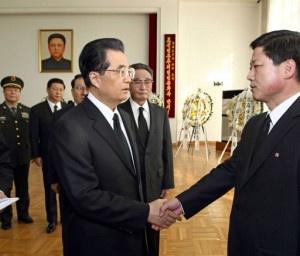A new era of increasing instability is opening in East Asia.
The death of North Korean leader Kim Il-Jong is only adding another, if explosive, element to an already volatile equation:
- China enters a period of substantially slower economic growth, if not a crash, on the eve next autumn of a takeover by a new generation of undistinguished Communist Party leaders.
- Japan wrestles with efforts to remake its domestic politics, but buoyed by its always magnificent; if constipated; bureaucracy, pursues a security buildup despite, ironically, a left-leaning governing party precariously clinging to power.
- South Korea’s miraculous ascendancy to world economic leadership and prosperity is imperiled by its export-led strategy now facing world economic shrinkage, and with the prospect of continued harassment from the North.
- North Korea attempts continuance of its highly leverage Communist monarchy but its balancing act could well succumb to both internal rivalries and Western pressure to halt its profitable foreign arms sales.
- Taiwan goes to another democratic election in January under the evil eye of Beijing that fears recent increasingly binding economic ties may be countered by “nationalists” intent on maintaining de facto independence.
- The Obama Administration has made new commitments, particularly in Southeast Asia, of resistance to aggressive Chinese claims despite rapidly reducing the navy as it backs out of two, long and inconclusive wars.

Beijing’s high growth rate — despite its majority largely left out of the Coastal Cities boom — is dropping precipitously, because of inherent weaknesses built into its state capitalism and the world economic downturn. Having abandoned Maoism two decades ago, conventional wisdom held such rapid growth essential to sustain one-party, elitist rule. While there is no organized national opposition, there are increasing signs local Communist cadre have lost control. Massive infrastructure overexpansion, declining export prospects and untenable internal debt levels could produce a breakdown.
Furthermore, Pyongyang provides new concern for Bejiing’s conflicted view of North Korea. China’s aid supports Pyongyang at the same time North Korea rejects “the China model”, the Kim leadership believing — after a failed trial — it could not maintain control were widespread private initiative permitted.
Contrary to conventional wisdom, refugee flows from an implosion resulting from the burden of one of the world’s largest militaries and developing weapons of mass destruction would not be the principal threat. What Beijing fears most would be Korean reunification, which led the young Communist China to risk intervention in the stalemated Korean War for control of the peninsula.
Again, conventional comparisons of Korean reunification to Germany are inappropriate. Assuming China could not prevent an internal crackup which might come suddenly — as it did to once seemingly impregnable East Germany and model Communist dictatorship Romania — South Korea could absorb a North Korean colony, and, in fact, longer term turn it to economic advantage.
To the consternation of Japan and the U.S., too, as well as China, the world might suddenly face a strong, new nuclear armed power.
As it has for a century, much will depend on China’s relationship with Japan, always uppermost in Beijing’s calculations. Beijing has rejected Tokyo’s proposal for defusing the Japan [East] Sea flashpoint by joint development of gas. Meanwhile, despite the leftwing careers of many now serving cabinet members and its declining population, Tokyo continues to move to quality manufacturing, heightened industrial R&D, and consolidating defenses with purchase of F35s from the U.S. [As always, Tokyo sees joint manufacturing arrangements enhancing Japan’s technology.]
The current U.S. defense appropriation dropped funds for moving American forces from Okinawa to Guam; probably not in the strategic interests of either country given the Island’s unique geographic centrality. The Japanese are pushing a trilateral strategic relationship with India and the U.S. — which may again include Australia now that Canberra is lifting its export ban on uranium to New Delhi — in a not very subtle effort to counter China’s Indian Ocean expansion, a continuing Tibet buildup and encroachment on northern India and Pakistan, and central Asian initiatives including Afghanistan.
Moves to end Japan’s postwar ban on arms exports could be strategically significant, negotiated, possibly, as part of the Obama Administration’s Trans Pacific Partnership still running up against protectionist Japanese agricultural interests.
Whatever else, pieces are moving rapidly on the Asian chessboard. But as always, unanticipated events are likely to dictate eventual outcome of the best laid plans of mice and allies.
Sol W. Sanders, ([email protected]), writes the ‘Follow the Money’ column for The Washington Times on the convergence of international politics, business and economics. He is also a contributing editor for WorldTribune.com and East-Asia-Intel.com.

